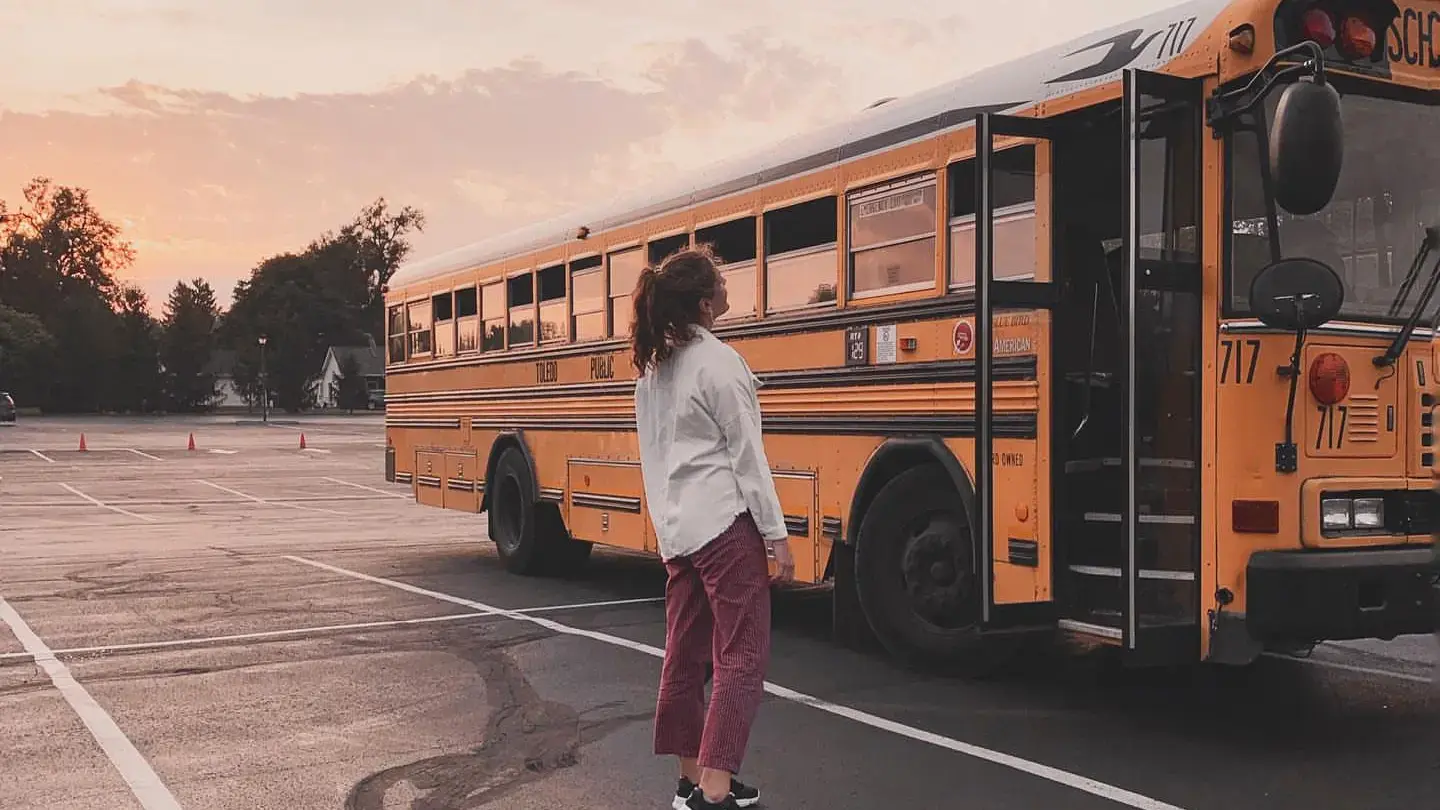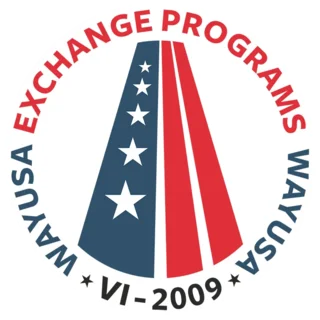How U.S. High Schools Work / Школьное Образование В США

HOW U.S. HIGH SCHOOLS WORK
HOW DOES THE EDUCATION SYSTEM IN THE UNITED STATES WORK, HOW MANY YEARS OF SCHOOLING ARE THERE, AND ARE THERE MANDATORY SUBJECTS?
American school is not like that
We usually learn about American High Schools from popular TV-shows and movies which show it as a fun but messy place. Cool guys playing sports, nerds who never leave their books’ pages, teachers who make you cocoa on a test day – are all of them just movie characters, and what the reality is like? Is the image of American High School as a place to study, have fun and express yourself at the same time close to the actual thing?
Let’s talk about it
SCHOOL SYSTEM
The US school education (also referred to as K-12 Education System) includes three steps, or schools: Elementary, Junior High School, and High School. In total, this gives us 12 years of school, including the first year called Kindergarten. In the US it is quite uncommon to attend one school for all the educational steps. Typically, kids study in 3 different places – one for each educational step – especially if they attend a public school. Americans start Kindergarten at the age of 5 or 6 and usually graduate at the age of 17 or 18, so whatever grade you are in as an Exchange Student, you’ll most probably have classes with your peers.
High School includes grades 9 through 12. Each of them has a common name everybody uses instead of a number.
These names are:
- 9 – Freshman
- 10 – Sophomore
- 11 – Junior
- 12 – Senior
Our Program’s first year participants are usually placed in 11th grade if the age criteria is met, and they have finished the relevant grade in their home country. Then, if a participant decides to continue being a part of Exchange Program and graduate American High School, they go to a different school in a different state where they are placed in 12th grade.
LEARNING PROCESS
In the US there is no such a thing like “classmates” as a group of people who stay together for all of their classes every day every year. Every student has their own schedule which is put together in the beginning of the school year. Such a way to organize the schedule is very smart. First of all, this way every student has an opportunity to choose their own elective classes and enjoy studying what they really like. Secondly, when everybody has their individual schedule planned, students have a chance to meet different people in different classes. This is a big advantage for an Exchange Student: you would not have to join a group of classmates who have been studying together for years, instead you would meet new people in every class. Isn’t it a great opportunity to make friends?
Speaking of the freedom of choice of classes to take students have, there are requirements for every subject, or discipline. These requirements set the amount of “credits” student must obtain in order to complete a grade and eventually graduate. This means that even though students get to choose some of their classes, there are also some that are compulsory to take. Classes that are up to the student’s choice are called electives, and usually American High School has a lot of them ro choose from. Have you ever imagined taking Drama or Journalism as a class? This is going to be your chance to do so!
GRADES
Grading in an American school is a very serious thing. There are strict criteria for grading each kind of student’s work. In general, there are 5 Letter Grades: “A”, “B”, “C”, “D” and “F”. “F” stands for “Failing” and should never be seen in your transcript not only because this means you’re not handling the class but also because this is a ground for expelling an Exchange Student from a program. Each of the grades has a percentage and a GPA 4.0 scale equivalent. GPA stands for “Grade Point Average” and is used to indicate how well you score in different classes. The majority of colleges and educational institutions use it as a primary rate of student’s academic performance.
GRADUATION AND TESTS
There are usually no compulsory exams or tests a student should pass in order to graduate. The only requirement is a certain amount of credits student should have earned in every discipline. Although there are no exams a student must pass, there are tests which are advisable to be taken before graduation: SAT or ACT. These are the standardized tests accepted by most colleges for admission purposes. SAT and ACT are extremely important to take for those who plan on applying for college.
However, not everybody in the US goes to college immediately after High School Graduation. The first reason is the cost of higher education in the US, the second one is the “gap year” – a year right after graduation a student takes to travel, consider their options, or work. One of the options to handle the high cost of college education is getting a scholarship – an amount of money a college or a state pays for your tuition. There are different types of scholarships: some of them are given for the best GPA, some of them – for athletic achievements. Getting a scholarship is quite challenging because it involves competing with a lot of other students but an opportunity to attend the college you’ve always dreamt about is absolutely worth it.
FRIENDS, CLUBS, SPORTS
High School is usually the time a lot of students get to work harder on their grades in order to graduate and be able to build a successful future. But there is always some time for socializing, hobbies and sports. Clubs and sports in American schools are just as important as books and tests. You should definitely be focused on your schoolwork but it’s also good to be actively taking part in clubs and athletics. Most High Schools provide their students with a lot of things to do after classes like Journalism, Politics, Volunteerism Programs, School Band and many other. Playing sports is also a big deal. Every High School has its own teams in multiple sports, and games attract a lot of spectators. Also attending such activities helps you make friends. It’s so much easier to start a conversation when both you and the other person have common interests.
Speaking of making friends, there is only one big rule: do not be afraid to reach out to people. In the new environment it might be challenging to get used to things but having someone by your side makes it easier and even fun. You will have an opportunity to meet new people in class, during the breaks, and after school, use it! The more open you are to people, the faster you adapt.

ШКОЛЬНОЕ ОБРАЗОВАНИЕ В США
КАК РАБОТАЕТ ОБРАЗОВАНИЕ В АМЕРИКЕ, СКОЛЬКО ЛЕТ ОБУЧЕНИЯ И ЕСТЬ ЛИ ОБЯЗАТЕЛЬНЫЕ ПРЕДМЕТЫ
АМЕРИКАНСКАЯ ШКОЛА НЕ ТАКАЯ
В любом подростковом сериале американская старшая школа (High School) — это отдельный мир: со своим укладом жизни, законами, своей иерархией.
Популярные на всю школу компании, крутые спортсмены, учителя, с которыми можно обсудить все, что угодно, директор, который классно шутит — персонажи из сценария или реальные люди?
Правда ли американская школа такая, какой ее рисуют медиа — со свободой мышления, увлекательным обучением и спортивными играми на тысячи зрителей каждую неделю?
Давайте разбираться!
SCHOOL SYSTEM
В США школьное образование состоит из трех ступеней, или школ:
- Elementary (начальная)
- Junior High School (средняя)
- High School (старшая)
Всего 12 лет обучения, начиная с Kindergarden – первого класса.
Школы K-12, обучающие детей все 12 лет, здесь редкость. Чаще всего каждую из ступеней образования ребенок проходит в разных местах, особенно если учится в государственной, а не частной школе.
Несмотря на то, что классов 12, американцы заканчивают школу, как правило, в том же возрасте, что и большенство детей в других странах – в 17-18 лет. Разницы не возникает, так как Kindergarden – это скорее переходный этап между школой и садиком, и детям там обычно 5-6 лет.
Старшая школа – это четыре класса:
- 9 - Freshman
- 10 - Sophomore
- 11 - Junior
- 12 - Senior
Участники программы на первом году обучения чаще всего размещаются в 11 класс, а если они принимают решение продолжить учиться в Штатах и выпуститься из американской школы, то на второй год становятся Seniors – самыми старшими и крутыми во всей High School.
За счет того, что в Америке нет разделения на классы, но только на параллели, в какой бы момент ты не оказался в школе, не будет стресса от входа в сформировавшийся коллектив, так как на каждом уроке будет возможность знакомиться с новыми людьми.
ПРОЦЕСС ОБУЧЕНИЯ
Так как нет разделения на классы, у каждого свое индивидуальное расписание, которое составляется в начале учебного года и повторяется изо дня в день.
Такая система позволяет выбрать те предметы, которые наиболее близки именно тебе: сделать акцент, например, на научные дисциплины, или на искусство и историю. Это помогает учиться более эффективно: в каждом классе с тобой только люди, которым правда интересен предмет.
Несмотря на свободу выбора, в каждом штате, естественно, есть определенные критерии, определяющие минимум учебных часов — credits — по нескольким основным дисциплинам:
- English
- Maths
- Science
- Social Studies
и другим:
- Art
- Physical Education
Таким образом, у каждого есть возможность планировать свое расписание так, чтобы совмещать обязательные предметы с любимыми.
Кроме привычных нам предметов в Америке много Electives – элективов, которые также можно включить в свое расписание и в учебное время заниматься, например, театральным мастерством или журналистикой.
Оценки по всем предметам выставляются в строгом соответствии с критериями, шкала: от “F” – failing (неудовлетворительно) по алфавиту до “A” – excellent (отлично).
Так как критерии и системы оценивания у разных школ могут отличаться, существует универсальный показатель успеваемости – GPA (Grade Point Average), который складывается из оценок по всем предметам и измеряется по шкале от 0 до 4. Именно этот показатель запрашивают Университеты и Колледжи, его же предъявляют при приеме на работу. Все оценки всегда конфиденциальны, и даже в рамках класса никогда не оглашаются.
ОЦЕНКИ
Система оценивания более строгая и стандартизированная, чем например в российской школе: есть четкое соответствие процента верного выполнения оценке (в таблице ниже). В течение четверти (семестра) каждый преподаватель выставляет баллы в разных категориях: домашнее задание, участие в классе, тесты, квизы. Каждая работа имеет определенный “вес”, выраженный в процентах. Например, домашние и классные – по 10%, а тест - 80%. Таким образом, на итоговую оценку гораздо сильнее влияет тест.
GPA (Grade Point Average) – универсальная шкала для расчета среднего балла. Этот показатель учитывают при поступлении в большинство университетов, зачислении в образовательные и исследовательские программы, приеме на работу. Формальный максимум – 4.0, но его можно превзойти засчет классов повышенной сложности (оценки в таких классах эквивалентны баллу, большему обычного на 1, то есть “А” – это 5.0 к GPA вместо 4.0).
Поддерживать отличную успеваемость несложно: система устроена так, что достаточно просто следовать указаниям, чтобы иметь заветные 100%. Кроме того, прямо в школе есть tutoring – в библиотеке после уроков можно вместе с учителями разобраться с проблемным предметом. Американские школьники не сталкиваются со стрессом из-за оценок, они знают, что улучшить GPA - решаемая задача, тем более, если обратиться к преподавателю.
ОКОНЧАНИЕ ШКОЛЫ
К экзаменам в США тоже совсем другой подход.
Тесты SAT и ACT — стандартизированы и используются при поступлении во многие университеты, но эти тесты никак не связаны с выпуском из школы.
Для того, чтобы закончить школу, нужно иметь достаточное количество credits, а тесты сдают только те, кто планирует с их помощью поступать в ВУЗ.
К высшему образованию здесь также другой подход. Во многих странах оно является логичным продолжением школьного, и случаи, когда дети после школы не планируют поступать — исключение, но в США из-за высокой стоимости высшего образования, оно является привилегией.
Старшеклассники много работают на то, чтобы иметь отличную успеваемость и хорошо сдать тесты, чтобы побороться за scholarships — гранты на обучение в университетах.
ОБЩЕНИЕ, УВЛЕЧЕНИЯ, СПОРТ
Несмотря на сосредоточенность на GPA, выпускном и тестах, школьники никогда не заняты только учебой: общение, спорт, хобби, клубы по интересам – все это также важно, как контрольные и эссе. Благодаря тому, что каждый урок ты проводишь с разными людьми, шансы завести друзей растут по экспоненте, ведь за день ты проводишь время не с 25-30, а более, чем со 100 одноклассниками.
Даже если стать друзьями сначала будет трудно, помогут учителя, которые никогда не бывают равнодушными: разговорят, развеяться твои страхи, помогут влиться в коллектив.
Возможно, кто-то из учителей сам станет твоим другом.
В Штатах отношения учитель-ученик строятся совсем по-другому, и их искренность сначала шокирует, а после согревает.
В учебное время тебе не только не скучно, но действительно хочется на каждый из уроков. После школы тебе не дадут уйти домой баскетбол, волейбол, чирлидинг, бейсбол, танцевальная команда – активные увлечения на любой вкус. Кроме спорта, есть еще множество клубов по интересам: политика, книги, волонтерская деятельность, приготовление десертов. Чем бы ты не увлекался, ты найдешь “своих”.
Такая многогранность школы помогает быстрее в ней освоиться, узнать больше людей и стать полноценным участником американской жизни.

